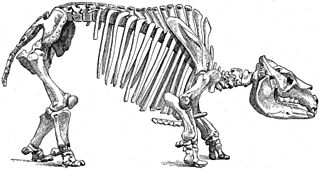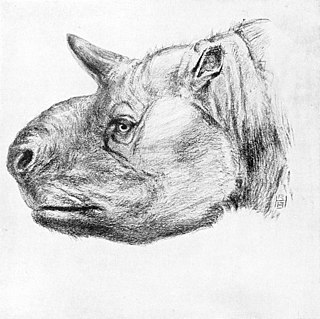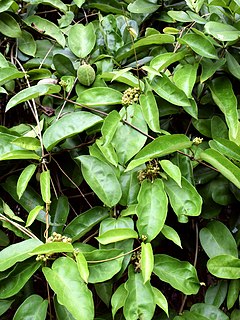
Notoungulata is an extinct order of mammalian ungulates that inhabited South America during the Paleocene to the Holocene, living from approximately 57 Ma to 11,000 years ago. Notoungulates were morphologically diverse, with forms resembling animals as disparate as rabbits and rhinoceroses. Notoungula were the dominant group of ungulates in South America during the Paleogene and early Neogene. Their diversity declined during the Late Neogene, with only the large toxodontids persisting until the end of the Pleistocene. Several groups of Notoungulates separately evolved ever growing teeth like rodents and lagomorphs, a distinction among ungulates only shared with Elasmotherium.

Macrauchenia was a large, long-necked and long-limbed, three-toed native South American mammal in the order Litopterna. The genus gives its name to its family, the Macraucheniidae or "robust litopterns". Like other litopterns, it is most closely related to the odd-toed ungulates (Perissodactyla), from which litopterns diverged approximately 66 million years ago. The oldest fossils in the genus date to the late Miocene, around seven million years ago, and M. patachonica disappears from the fossil record during the late Pleistocene, around 20,000-10,000 years ago. M. patachonica is one of the last and best known member of the family and is known primarily from the Luján Formation in Argentina, but is known from localities across southern South America. Another genus of macraucheniid Xenorhinotherium was present in northeast Brazil and Venezuela during the Late Pleistocene. The type specimen was discovered by Charles Darwin during the voyage of the Beagle. In life, Macrauchenia may have resembled a humpless camel, though the two taxa are not closely related. It fed on plants in a variety of environments across what is now South America. Among the species described, M. patachonica and M. ullomensis are considered valid; M. boliviensis is considered a nomen dubium; and M. antiqua has been moved to the genus Promacrauchenia.

Trigodon is an extinct genus of the family Toxodontidae, a large bodied notoungulate which inhabited South America during the Late Miocene to Early Pliocene, living from 11.61—4.0 Ma and existed for approximately 7.61 million years . The type species is T. gaudryi.
Asmodeus is a demon-like figure from the Book of Tobit.
Zenostephanus is true ammonite genus from the lower part of the Upper Jurassic of eastern England and Scotland belonging to the ammonitid family, Perisphinctidae.
Brachystephanus is a genus of plants in the family Acanthaceae. It contains the following species :
Brachystephanus kupeensis is a species of plant in the family Acanthaceae. It is endemic to Cameroon. Its natural habitat is subtropical or tropical moist lowland forests.
Henricosborniidae is a family of extinct notoungulate mammals known from the Late Paleocene to Early Miocene of Argentina, Bolivia and Brazil. The name honors U.S. paleontologist Henry Fairfield Osborn.

Mesotheriidae is an extinct family of notoungulate mammals known from the Eocene through the Pleistocene of South America. Mesotheriids were small to medium-sized herbivorous mammals adapted for digging.
Campanorco is an extinct genus of notoungulate mammal from the Middle Eocene Lumbrera Formation, Argentina, South America and the only member of the family Campanorcidae.

Notioprogonia is a suborder of the extinct mammalian order Notoungulata and includes two families, Henricosborniidae and Notostylopidae.

Mesotherium, synonym, "Typotherium," is the type genus of Mesotheriidae, a long-lasting family of superficially rodent-like, burrowing notoungulates from South America. It was first named by Étienne Serres in 1867, and through further finds now contains four species, M. cristatum, M. hystatum, M. maendrum, and M. pachygnathum. Fossils have been found in the Miramar and Vorohué Formations of Argentina.
B. giganteus may refer to:
Xenostephanus may refer to:

Sarcolobus is a plant genus in the family Apocynaceae, first described as a genus in 1810. It is native to Southeast Asia, New Guinea, Australia, and certain islands of the Western Pacific.
- Sarcolobus brachystephanus(Schltr.) P.I.Forst. - New Guinea
- Sarcolobus hullsii(F.Muell. ex Benth.) P.I.Forst. - Australia
- Sarcolobus kaniensis(Schltr.) P.I.Forst. - New Guinea
- Sarcolobus secamonoides(Schltr.) P.I.Forst. - New Guinea
- Sarcolobus spanogheiMiq. - Java
- Sarcolobus sulphureus(Volkens) Schltr. - Caroline Islands in Micronesia
Griphotherion is an extinct genus of notoungulate mammal from the Eocene of Argentina. A fossil skeleton was found in the Lumbrera Formation and described in 2011 as the holotype of the type species G. peiranoi.
The Santa Rosa local fauna consists of the animals found in the Paleogene fossil site of Santa Rosa in eastern Peru. The age of the Santa Rosa fauna is difficult to determine, but may be Eocene (Mustersan) or Oligocene (Deseadan).

Huilatherium is an extinct genus of leontiniid, a group of hoofed mammals belonging to the order Notoungulata, that comprises other South American ungulate families that evolved in parallel with some mammals of the Northern hemisphere. The leontiinids were a family of herbivorous species comprising medium to large browsers, with relatively short skulls and robust limbs, somewhat similar to their relatives, the best known toxodontids.

Piauhytherium is an extinct genus of herbivorous notoungulate mammal of the family Toxodontidae. It lived during the Late Pleistocene, about 10,000 years ago; fossils have been found in Brazil. The only known species is Piauhytherium capivarae.

Miocochilius is an extinct genus of small notoungulate mammals native to South America. The genus lived during the Middle Miocene epoch. The genus contains two described species, the type species M. anomopodus described in 1953 by Ruben Arthur Stirton and M. federicoi, described and included in the genus by Darin A. Croft.
This page is based on this
Wikipedia article Text is available under the
CC BY-SA 4.0 license; additional terms may apply.
Images, videos and audio are available under their respective licenses.








